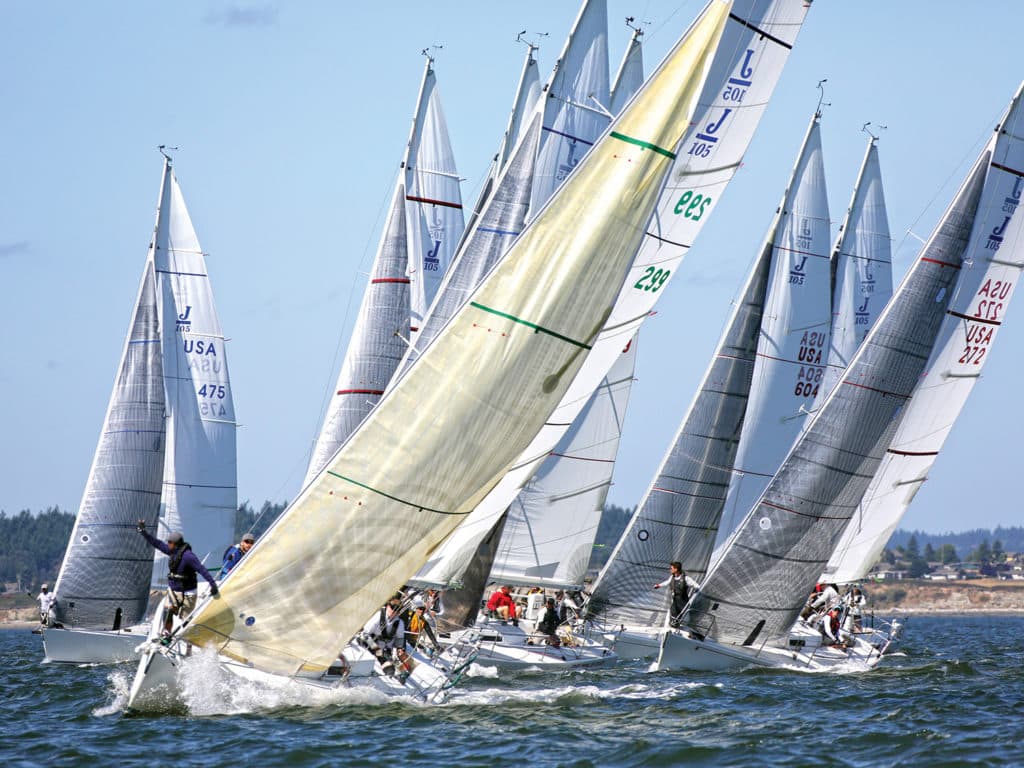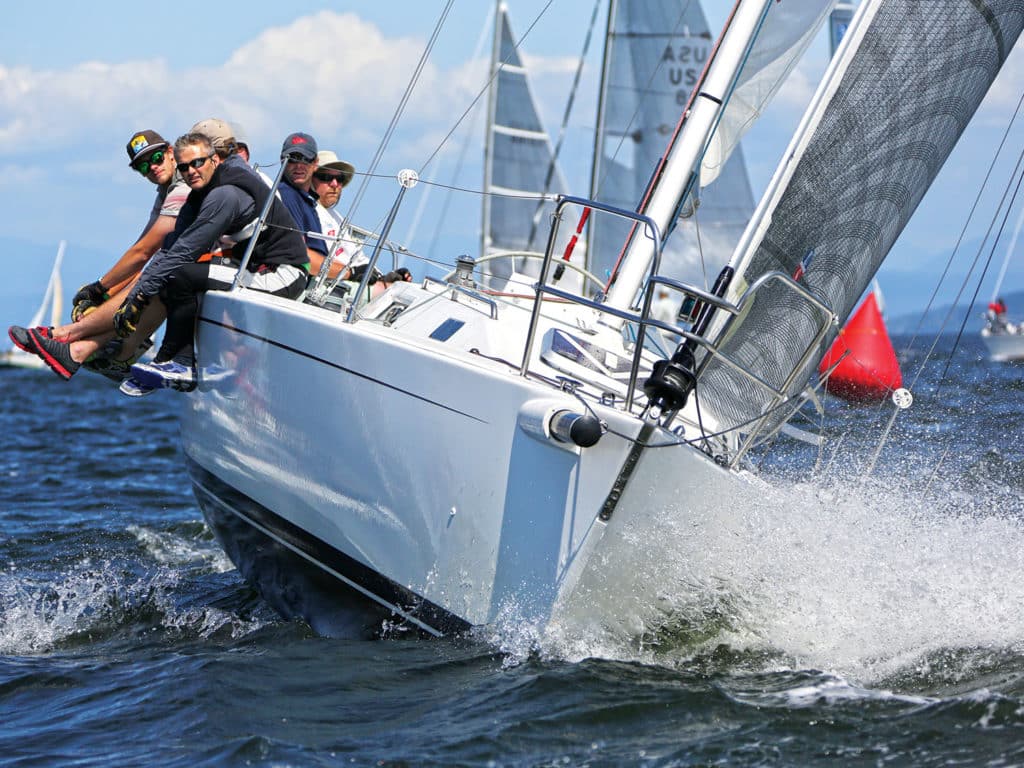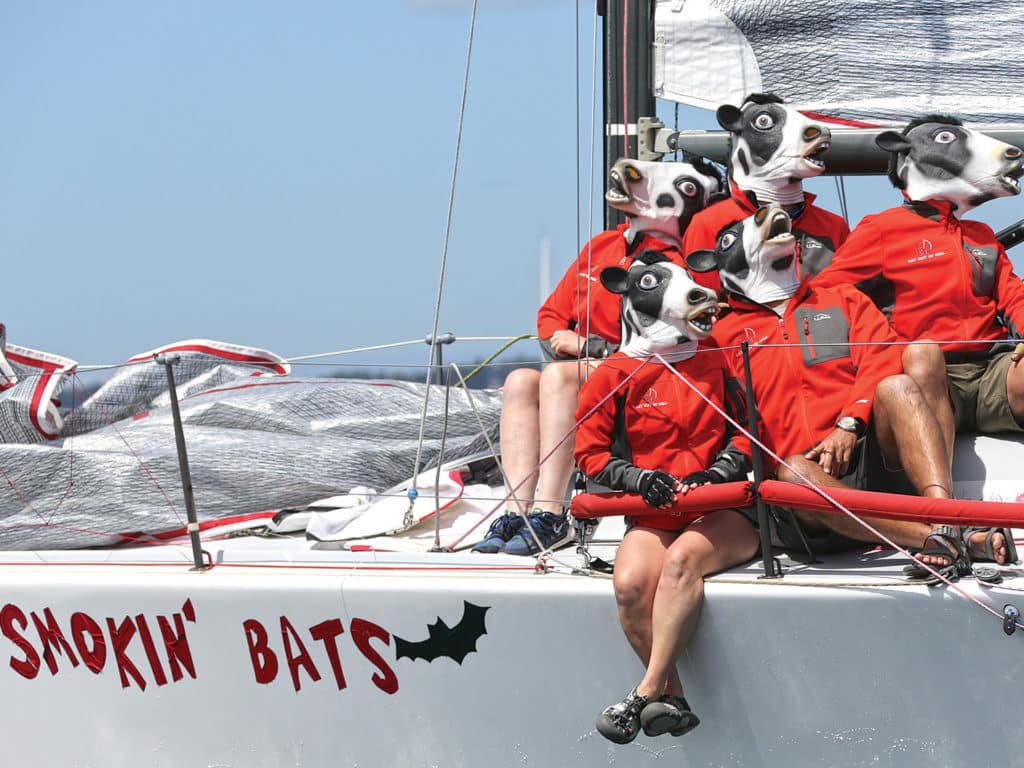
The future was looking grim for Whidbey Island Race Week. The annual July invasion of the quiet confines of the Washington island’s Oak Harbor and Penn Cove was waning. What once decades ago numbered 150 boats petered to 60-something. Small boats couldn’t get launched because the city wouldn’t fix the crane. Bigger boats couldn’t get into the marina because the channel wasn’t dredged. National sponsors took a pass.
It appeared the wind-delay water fights, shoreside volleyball and golf tournaments, epic bowling nights and bacon-offs in the campground would evaporate, as so many race weeks have around the country.
But the soggy sailors of the Salish Sea had pulled the “Adult Summer Camp” from the jaws of death before and weren’t ready to give up on it now. Race Week owner Schelleen Rathkopf and her advisory board decided a move to Point Roberts in 2020 could spark a revival.
Point where? Roberts.
“I’ve sailed here 30 years,” says longtime Whidbey participant Charlie Macaulay, “but I’ve actually never been to Point Roberts.” He plans to sail next year.
The name doesn’t exactly ring a bell on the Pacific Northwest sailing scene, but it might well be the right place at the right time. The racing community knew a move away from Oak Harbor was coming, but conventional thought had it going to Anacortes or Port Townsend, already popular racing and cruising destinations.

The Point Roberts “surprise” is actually a very fitting move. The town is craving more visitors and an enthusiastic community is eager to make it work. In fact, it’s much like Whidbey Island Race Week’s beginnings. When boat dealer and chamber of commerce vice chairman Stan Stanley started his race week in 1983, it was largely to generate excitement and commerce for the then little-known port of Oak Harbor. It generated that business for decades.
Point Roberts is anticipating a similar boost. While it doesn’t have the infrastructure of a naval-air-station town such as Oak Harbor, it does have beautiful campgrounds and Airbnbs.
And there’s already an away-from-it-all resort feel with parks everywhere and beaches galore. The famous race-week camping community will have several options.
On the sailing aspect, Point Roberts has many key ingredients to be a successful host. It has plenty of racing room for several round-the-buoys circles and options for longer-leg, cruising-class courses. Racing can be set up immediately outside the harbor, opening up the possibility for dinghy racing. The harbor is deep enough for TP52s and there is a 35-ton Marine Travelift and a 3,000-pound hoist.

The small port town is uniquely situated on the land south of the 49th Parallel on the tip of the (Canadian) Tsawwassen Peninsula, so one is either getting there by water from the United States or crossing a border. For sailors coming from the States that actually means two borders, getting into Canada, then crossing back into the United States. Organizers have anticipated difficulties arising from U.S. sailors with DUIs on their records not being able to get into Canada; the solution is a 15-minute ferry ride from Blaine to Point Roberts with no border crossings.
Point Roberts presents a very different delivery from the various other sailing centers in the region. While Oak Harbor was a one-day delivery for Seattle boats, the 91-mile delivery to Point Roberts would take two days or a really long day for a big boat. On the other hand, Point Roberts is about 20 miles from Vancouver. It’s an easy delivery from Anacortes, Bellingham and Victoria.
Racers might also use Point Roberts as a starting point for a cruise after race week. The renowned cruising grounds of the Gulf Islands and Strait of Georgia beckon, and returning south through the San Juan Islands could be a fine cruise in itself.
One thing that will have to be confronted head-on will be the handicapping issue. While the Pacific Northwest is one of the original PHRF strongholds, for several decades now there’s been a parting of the ways between PHRF-Northwest—mainly in the States—and PHRF-BC in Canada, and there can be small but significant differences in handicaps and a lack of cooperation between the two. PHRF handicapper Matt Wood anticipates that “good faith between both organizations” will make it work. History, however, suggests otherwise. There’s a growing big-boat fleet, and it’s anticipated that ORC will have to be offered to attract the several TP52s that now call the Northwest home. And, of course, one-design fleets such as the J/105s and Melges 24s have often used Race Week for their class events.
One appeal of Point Roberts is it’s not Whidbey Island. After 37 years, the arena-type racing waters of Penn Cove was old hat for veterans.
The Adult Summer Camp has cheated death already. Stan Stanley found the original sponsor with Yachting Magazine, so not only did Whidbey Island Race Week have money, but it had media exposure as well. Then came 1994, the year bean counters at Ziff-Davis decided Whidbey Island Race Week was just not making enough money for them and withdrew their support four months before the event. J/Boats dealer Bob Ross came to the rescue with help from regional sponsors such as Fisheries Supply.
One appeal of Point Roberts is it’s not Whidbey Island. After 37 years, the arena-type racing waters of Penn Cove was old hat for veterans. There was the reverse-toilet-bowl current and the lifts off the beach. Been there, done that. Because nobody has raced around Point Roberts, the newness of the challenge might be enough to attract some serious racers. And there are plans for serious dinghy racing, which could certainly broaden its appeal.
On the social side of things, Rathkopf has aggressively changed Whidbey Race Week from its raucous-all-the-time reputation to a more family-oriented event with a sailing camp and special activities for kids, which will continue with Point Roberts Race Week.
Over the years, the fleets shrank, harbors became shallower and hoists broke down; while Stanley and other Oak Harbor sailors shake their heads a bit about the move and Northwest sailors try to wrap their heads around new currents to learn, Rathkopf is taking a very positive outlook.
“Point Roberts is the perfect venue,” she says with the conviction of an organizer. Now it’s up to the sailors to find out exactly where it is on the chart and how to get there.









